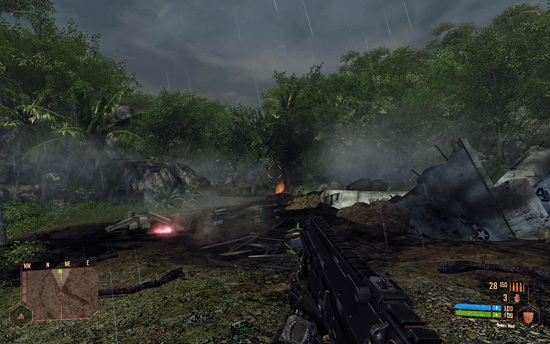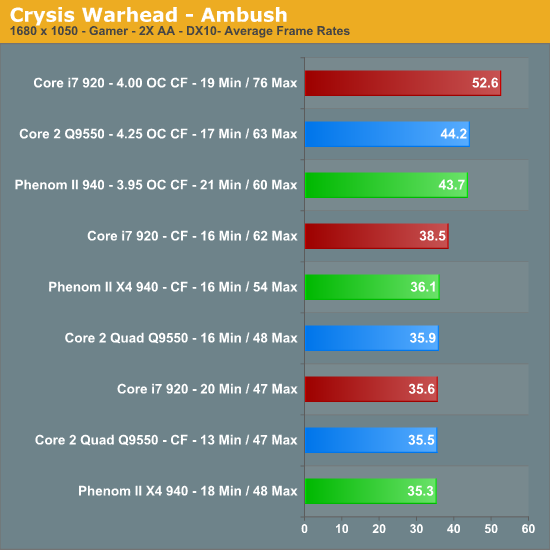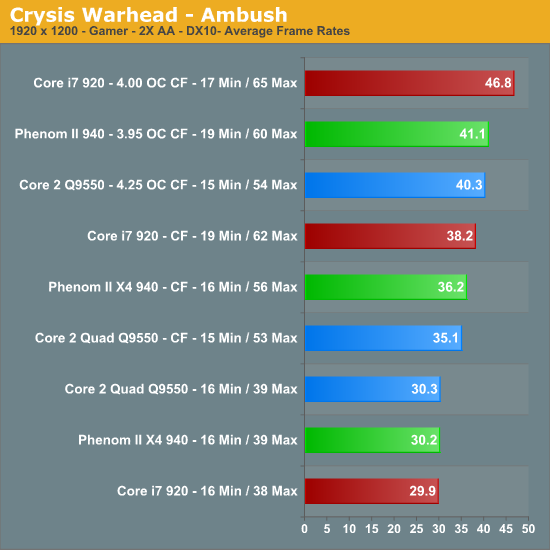CrossFireX and the Phenom II X4 940 – Competitive or Not?
by Gary Key on February 2, 2009 12:00 AM EST- Posted in
- Motherboards
Crysis Warhead

Crysis Warhead is an update to the original game with a storyline that takes place on the other side of the Island during the same time-period as the first. The game features an enhanced and optimized version of the CryEngine 2 but is still a resource monster. We set the graphics options to Gamer, DX10, and 2xAA and play back a timedemo that covers the Ambush level. We have to admit at these settings that the game looks fantastic during action scenes and game play is acceptable.

At 1680x1050, all three platforms are clustered together in single card and CrossFire configurations. We also see why a single GPU card can be a better value than a dual GPU solution at this resolution in certain games. It is not until we overclock that we notice some separation between the platforms with the i7 taking a decent lead, but its minimum frame rates do not improve compared to a single card setup. However, our Phenom II setup offers the best minimum frame rates when overclocked and actually offers a slight improvement over its single card scores.
Adding a second card for CrossFire operation improves average frame rates by 2% and minimum frame rates decrease 12% for the Phenom II. The Intel Q9550 has a decrease of 1% in average frame rates and 19% in minimum frame rates. The Core i7 average frame rates improve by 8% and minimum rates decrease by 20%. Overclocking our processors resulted in a 22%~36% improvement in average frame rates with the Core i7 benefiting the greatest.

Our 1920x1200 test follows a similar pattern with all three solutions equal in single card testing and CrossFire showing a slight advantage to the i7. The Phenom II is slightly ahead of the Q9550 when overclocked, though it is at a 7% clock speed disadvantage. We have noticed CryEngine 2 will respond to improved memory bandwidth and latencies as we clock up the processors. The i7 holds a 14% advantage in average frame rates while the Phenom II once again impresses us with the best minimum frame rates when overclocked. However, not having a 20fps minimum frame rate is a disappointment with our multi-GPU setups. The NVIDIA 260/285 solutions scale better in SLI than the ATI HD 4870 products. We hope that ATI can improve their drivers for this game.
Adding a second card for CrossFire operation improves average frame rates by 20% but minimum frame rates do not change for the Phenom II. The Intel Q9550 has an improvement of 17% in average frame rates and a decrease of 6% in minimum frame rates. The Core i7 average frame rates improve by 27% and minimum rates increase 18%. Overclocking our processors resulted in a 14%~22% improvement in average frame rates with the Core i7 benefiting the most.
After playing through the several levels on each platform, we thought the Phenom II 940 offered a better overall gaming experience in this title than the Intel Q9550 based on smoother game play. It is difficult to quantify without a video capture, but player movement and weapon control just seemed to be more precise. Of course, if you have the funds, we would recommend the i7 platform for best possible performance.










68 Comments
View All Comments
Joe Schmoe - Tuesday, February 3, 2009 - link
This was a very good article. I'm not quite ready to build a new system just yet. But it is tax return season. I'm glad the Phenom II is competitive. We all win when AMD puts out a nice chip. I was about to jump on the I7 band wagon but decided to just grab a q6600 and save my coins for now. Hopefully this will end some of the endless flame wars going on through the forums.
Aquineas - Tuesday, February 3, 2009 - link
First of all, thanks for the hard work you put into testing. Many folks are getting hung up on 5-10 percent performance differences and making a big deal out of it . I think the most important part of the article is the part where it says, repeatedly (paraphrased):"We couldn't perceive a difference in gaming performance between platforms."
That being said, I think 18 months from now we'll see more games where the CPU differential matters more, which is right around the time I'll be doing my next system build.
myterrybear - Tuesday, February 3, 2009 - link
I agree with this as well, great job on the article & shows the point as I have ALWAYS said, when it comes down to it would ya even notice the diffrence between the 2 if you had just sat down on it & started to do stuff on it ??Yeah exactly 6 or 8 gig ram on Phenom II would be interesting, I know I've found 4 gigs on Phenom I to be very nice now that I am running a full 64bit os ( win 7 beta) on a oc to 3 ghz Phenom 9850 be. I'm just awaiting to see how things will be once I get my Phenom II 940 any second now. :)
myterrybear - Tuesday, February 3, 2009 - link
My thing that I am noticing with all these tests of core i7 vs phenom II is the fact the systems are not even ramwise. I mean what would a core i7 run like with 4 gigs of ram or if the phenom II platform had 6 gigs of ram.it's a valid argument I think.
Aquineas - Tuesday, February 3, 2009 - link
Honestly, it probably wouldn't matter much. If I were the author I'd re-run the test with 8GB on the PII, but it's probably less than a 2 percent differential.BlueBlazer - Tuesday, February 3, 2009 - link
Love to see Intel and AMD in SLI numbers!ThePooBurner - Monday, February 2, 2009 - link
Am i the only one that noticed that the results for the PhenomII were just about identical between resolutions? There should have been some form of difference unless the AMD platform is being artificially hard-capped for some reason. Otherwise that the frame rates would be identical when upping the resolution makes no sense at all. I suggest looking into it further.ThePooBurner - Monday, February 2, 2009 - link
Err, Crysis Warhead is what i meant by FarCray2.7Enigma - Tuesday, February 3, 2009 - link
This is a perfect example of why the full data is so incredibly important in teasing out the details.Yes if you look at the graphs they show a very close clustering for the single card, CF, and overclocked CF, but if you look to the right of the names you will see the min and more importantly max will scale with upgraded components. Not to the same level as one would like but there appears to be some really REALLY rough sections as the min frame rate is almost identical across the board (look at single vs. CF you see the same frame rate). That is probably due to some driver issue where both cards are not being utilized and the single card is not optimized well either.
ThePooBurner - Wednesday, February 4, 2009 - link
I think you are missing my point. When going to a higher resolution it is expect that the frame rates for a card will change. Both the min and the max as well as the average. In almost every single game tested the values for the ATi cards at all resolutions are nearly identical. This smells very fishy to me and makes me think there is some sort of artificial limit being placed on the ATi hardware.